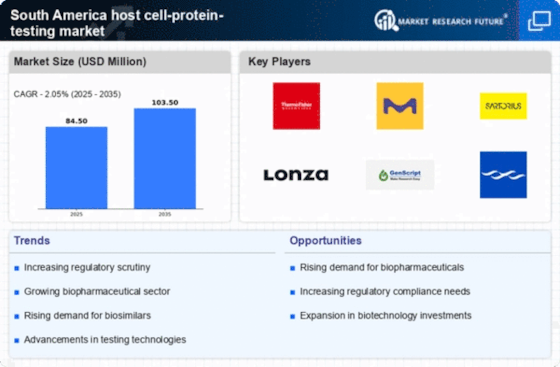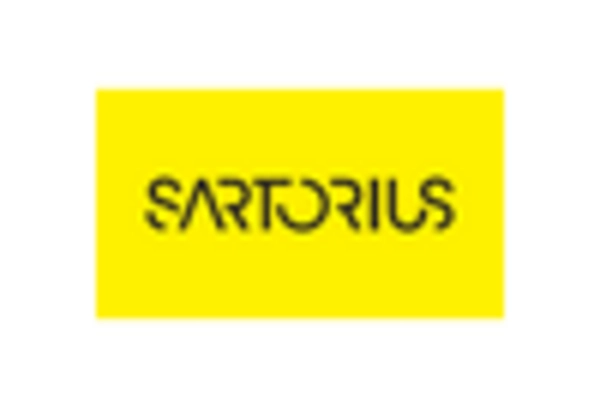Emergence of Biosimilars
The emergence of biosimilars in South America is significantly influencing the host cell-protein-testing market. As the biosimilar market expands, the need for thorough testing of host cell proteins becomes increasingly critical to ensure that these products are comparable to their reference biologics. By 2025, the biosimilars market in South America is projected to grow at a CAGR of 20%, highlighting the potential for increased testing requirements. This growth is likely to drive demand for specialized host cell-protein-testing services, as manufacturers seek to validate the safety and efficacy of their biosimilar products. Consequently, the host cell-protein-testing market stands to gain from this trend, as companies prioritize rigorous testing to meet regulatory expectations and consumer safety standards.
Growing Regulatory Scrutiny
The increasing regulatory scrutiny surrounding biopharmaceutical products in South America is a crucial driver for the host cell-protein-testing market. Regulatory bodies are implementing stringent guidelines to ensure the safety and quality of biopharmaceuticals, necessitating comprehensive testing of host cell proteins. In 2025, it is anticipated that compliance costs for biopharmaceutical companies could rise by up to 15%, emphasizing the importance of robust testing protocols. This heightened focus on regulatory compliance compels companies to invest in reliable host cell-protein-testing services, thereby expanding the market. The host cell-protein-testing market must adapt to these evolving regulations, ensuring that testing methodologies align with the latest standards to facilitate smoother product approvals and market entry.
Rising Biopharmaceutical Demand
The increasing demand for biopharmaceuticals in South America is a key driver for the host cell-protein-testing market. As the biopharmaceutical sector expands, the need for rigorous testing of host cell proteins becomes paramount to ensure product safety and efficacy. In 2025, the biopharmaceutical market in South America is projected to reach approximately $20 billion, indicating a robust growth trajectory. This surge necessitates advanced testing methodologies to detect and quantify host cell proteins, thereby propelling the market forward. Furthermore, the growing prevalence of chronic diseases in the region amplifies the need for innovative therapeutic solutions, further driving the demand for host cell-protein-testing services. Consequently, the host cell-protein-testing market is poised to benefit significantly from this upward trend in biopharmaceutical production.
Increased Investment in Biotechnology
Investment in biotechnology is witnessing a notable rise in South America, which serves as a significant driver for the host cell-protein-testing market. Governments and private entities are channeling funds into biotechnology research and development, fostering an environment conducive to innovation. In 2025, it is estimated that biotechnology investments in the region could exceed $5 billion, reflecting a growing recognition of the sector's potential. This influx of capital is likely to enhance the capabilities of laboratories and testing facilities, enabling them to adopt advanced technologies for host cell-protein testing. As a result, the host cell-protein-testing market is expected to experience accelerated growth, driven by improved testing accuracy and efficiency, which are critical for the successful development of biopharmaceutical products.
Advancements in Analytical Technologies
Advancements in analytical technologies are playing a pivotal role in shaping the host cell-protein-testing market in South America. The introduction of innovative testing methods, such as mass spectrometry and high-performance liquid chromatography, enhances the accuracy and efficiency of host cell-protein detection. In 2025, it is projected that the adoption of these advanced technologies could increase testing throughput by up to 30%, allowing laboratories to meet the growing demand for testing services. This technological evolution not only improves the reliability of test results but also reduces turnaround times, making it a vital driver for the host cell-protein-testing market. As laboratories invest in state-of-the-art equipment, the overall quality of testing services is expected to improve, further propelling market growth.


















Leave a Comment